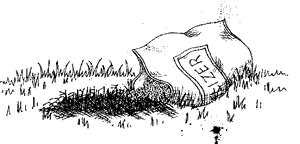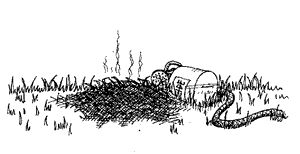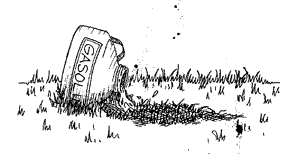About Dead Patches
From time to time, otherwise pretty decent lawns develop problems in small, localized areas for some reason. Typically grass suddenly dies or disappears in one or more patches that seem to defy explanation. Sometimes the cause is a pest or disease, or a patch of weeds that has died out and left bare soil. Often, though, it is environmental.
For instance, the kids or postman shortcuts over the grass to the neighbor’s yard, gradually wearing the grass away until suddenly there is a brown path. Or the dog does what comes naturally, and creates patches of dead grass every place where it marks its territory. Spills of fertilizer or gasoline also leave telltale dead spots in the turf. Setting a pail or other object on the lawn for a period of time will also kill the grass beneath. Areas where salt spray from winter snow plows splashes on the lawn look sickly. Whatever the cause, these areas are easily repaired to restore the beauty of your lawn.
Dog Urine
Dog urine, especially female dog urine, kills grass. To prevent grass damage you must be aware of the problem and drench the soil in the affected spot with fresh water within an hour or so of the occurrence. Usually the problem is detected well after the fact--signalled by a patch of lawn with a dead brown center surrounded by grass made unusually green by the nitrogen in the urine.
Protect the lawn and avoid having to repair spots constantly by designating a certain part of the yard for the use of the dog and train her to go there. Spread wood chips and/or plant tough groundcover plants behind some shrubs in a penned area or build a doggie sandbox. The area should be at least 30 to 40 square feet in size, because female dogs do not like to go in exactly the same spot each time. If it is large enough, weather usually dissipates the older odors, so the dog can continue to use the restricted area. Some dog owners train their pets to use a boxed raised bed 4 feet by 8 feet filled with sand. Just be sure to keep the neighborhood kids out of it.
Fertilizer Burn
 |
A prompt drenching with buckets of fresh water may forestall grass damage. However, once the grass is burned, it dies and must be replaced. Another solution to potential lawn damage from fertilizer spills is to use granular slow-acting fertilizer around the yard. Because its nitrogen is designed to act more slowly, an accidental overdose does not harm grass or soil.
Herbicide Spill
Herbicides are useful and effective lawn care products for killing weeds when used as directed on the label. In concentrations typical of a spill, (a tipped over spreader or dropped sprayer) they will certainly kill the grass under the spill. This also creates a problem of toxic soil at that spot.
 |
As a precaution, prior to repairing a patch of lawn dead from herbicide poisoning, dig up about 3 or 4 inches of the soil under the spot and dispose of it in the trash. Prepare and mix garden chemicals of any kind on the driveway or other paved area that can be washed if a spill occurs. Spread some newspapers or plastic sheeting under the work area to catch any waste. Always wear long-sleeves and pants, plastic or rubber gloves, and some kind of safety glasses when mixing any herbicide or insecticide. Wash with soap and water after using these chemicals.
Gasoline or Oil Spill
 |
Gasoline mulching lawn mowers, and even gasoline-driven string trimmers make lawn care much easier. Unfortunately over 17 million gallons of gasoline are spilled by homeowners each year when filling the tanks of these and other power tools. Since gasoline or oil kills grass on contact, that makes lawn damage from gas spills fairly common. Petroleum products contaminate the soil as well, so it is important to dig up about 3 or 4 inches of the soil under the spill and dispose of it in the trash prior to repairing the turf at that spot.
To eliminate the potential for gas spills when fueling a power tool attach a special dripless spout to a regular gasoline storage can. Use a safety fuel container equipped with this type of spout. Look for these containers at the hardware store or in a home center. Fill the tanks of this equipment on a paved area that can be washed off.
Worn Paths
In areas of the lawn that are worn down from repetitive foot traffic the grass dies both because its foliage is crushed and the soil is so compacted that its roots can no longer penetrate to access nutrients. The easiest way to prevent the development of a path in the lawn is to divert foot traffic. Block access to the area with a fence, mass of flowers or grove of prickly shrubs or groundcover.
If that is not possible, then try to sustain the persecuted grass plants by using a hand spiking tool to punch holes in the soil to aerate it every week or two. This is most effective from June through September when the summer heat stresses the grass. Spiking the soil allows air and water to reach roots trying to grow in the compacted turf. Eventually, careful preparation of the soil will be necessary before reseeding it.
Moss Patches
Poor soil also creates dead patches in the lawn. Soil that is very acid, compacted, shaded and/or damp does not sustain turf grass. Instead, mosses, tiny non-flowering plants that grow in velvety-green fuzzy mats, take over the area. One way to deal with this is to accept and nurture the moss, a lovely plant requiring no maintenance (unlike turfgrass). An alternative is to replace the moss with a dependably green, easy-growing groundcover like English ivy or pachysandra.
If you must have turfgrass in the area first rake up the moss or kill it with a moss and algae killer. Then change the environmental conditions to suit turfgrass. This is not always easy to do. Increase the light by pruning trees or shrubs, reduce soil acidity by adding lime to the soil, aerate the soil to correct compaction problems, solve any drainage problems that make it chronically damp, and then overseed with a shade-tolerant grass seed mixture containing mostly fine fescue.

